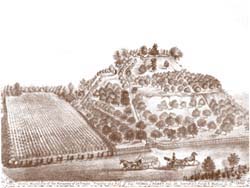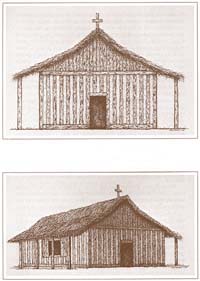
 |
Drawing of Monks Mound from an 1873 atlas of Madison County, Illinois.
by John A. Walthall and Robert E. Warren |
The archaeological and historical data presented in this study indicate that Monks Mound was the site of a French colonial mission and Cahokia Illini settlement . . . established in 1735. (John A. Walthall and Elizabeth D. Benchley, 1987)![]()
In the early 1730s, tensions arose between French colonists living at their Cahokia settlement and Illinois Indians of the Cahokia tribe who lived in a nearby village. At the suggestion of the French, a large group of Cahokia agreed to resettle at a more distant location. To encourage this move, French priests promised to give them trade goods, build them a chapel, and plow new fields. The Cahokia moved northward to a major landmark in the broad Mississippi River floodplain, a place now known as Monks Mound. This huge earthwork, the largest prehistoric mound in North America, was constructed by prehistoric Mississippian peoples and abandoned in the 1300s. However, by the 1700s it was known only as an unusual hill in the otherwise flat floodplain. The Cahokia built their village on the first terrace of the great mound and lived there for about 17 years. They were forced to resettle near the French garrison at Fort de Chartres after an attack by the Sauk, Fox (Mesquakie), Kickapoo, and Dakota (Sioux) tribes in 1752.
Artist's reconstruction of French chapel built at the River L'Abbe Mission Site.

![]()
Beginning in 1964, excavations on Monks Mound revealed evidence of this long-forgotten Illinois village. Archaeologists discovered the remains of a timber-and-thatch chapel and an associated cemetery in the extreme southwest corner of the terrace. Also found on the terrace were the remains of a wigwam-type house, smudge pits filled with charred corn cobs that may have been used to cure animal hides, and deep storage pits filled with garbage. The name of the site, River L'Abbe Mission, comes from an 18th-century name (River L'Abbe, or 'river of the priest') formerly used to identify the stream that flows past Monks Mound, which is now known as Cahokia Creek.
Artifacts recovered from the site include glass beads, a glass pendant made of melted beads, Catlinite pendants, a brass bell decorated with four raised fleur-de-lys designs, and several iron keys.
![]()
Iron key from the River L'Abbe Mission site (1735-1752). (ISM 1988-99.19; length=66mm)
In 1997, archaeologists from Southern Illinois University-Edwardsville discovered another large refuse-filled pit during excavations conducted prior to the construction of a new walkway on the mound. Material removed from the pit included sherds of French ceramics, pieces of metal scrap, glass beads, and numerous animal bones. The variety of animals represented in the pit and the completeness of the bones suggest that they may represent the remains of a specific event, perhaps a feast. It is well known that the Illinois took great pride in hosting large feasts to commemorate significant occasions.![]()
|
|
Copyright © 2000 Illinois State Museum
